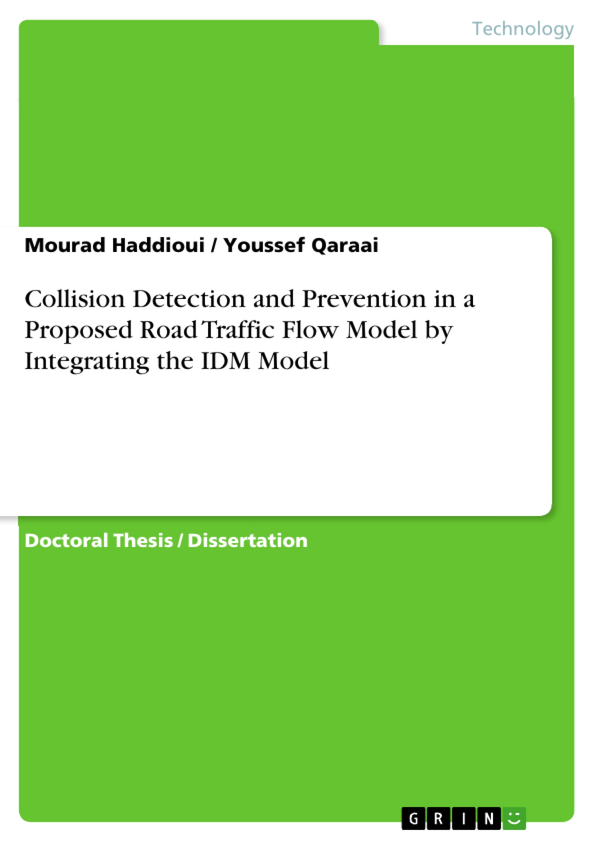
Collision Detection and Prevention in a Proposed Road Traffic Flow Model by Integrating the IDM Model
Doktorarbeit / Dissertation, 2024
114 Seiten
Leseprobe
Table of Contents
- Preface
- 1 Introduction
- 2 Overview of Road Traffic
- 2.1 Introduction
- 2.2 State-of-the-art of speed-density models
- 2.2.1 Greenshields Model
- 2.2.2 Greenberg Model
- 2.2.3 Underwood Model
- 2.2.4 Newell Model
- 2.2.5 Drake Model
- 2.2.6 Pipes Model
- 2.2.7 Drew's Model
- 2.2.8 Del Castillo's Model
- 2.2.9 Aerde's Model
- 2.2.10 Mac Nicholas's Model
- 2.3 Fundamental diagram of traffic
- 2.3.1 The traffic variables
- 2.3.2 LWR model
- 2.4 Conclusion
Objectives and Key Themes
This book aims to present a novel macroscopic traffic flow model that integrates the Intelligent Driver Model (IDM) and utilizes Physics-Informed Neural Networks (PINNs) for improved accuracy in modeling and predictive control, ultimately contributing to collision prevention in road traffic systems. The work combines macroscopic traffic theory, numerical techniques, machine learning, and simulation tools for a comprehensive framework. * Modeling and simulation of road traffic flow. * Collision prediction and prevention techniques. * Integration of the Intelligent Driver Model (IDM). * Application of Physics-Informed Neural Networks (PINNs). * Analysis of macroscopic traffic flow dynamics.Chapter Summaries
1 Introduction: This chapter likely sets the stage for the entire book, introducing the critical global issue of road traffic collisions and highlighting the need for advanced modeling and predictive control systems. It will establish the context of the research, emphasizing the importance of integrating data-driven technologies and intelligent control systems to improve road safety and urban mobility. The chapter will likely introduce the proposed novel traffic flow model and its core components, providing a roadmap for the subsequent chapters. 2 Overview of Road Traffic: This chapter offers a comprehensive review of existing speed-density models in traffic flow theory. It delves into various established models such as Greenshields, Greenberg, Underwood, Newell, Drake, Pipes, Drew's, Del Castillo's, Aerde's, and Mac Nicholas's models, comparing their strengths and weaknesses. A critical examination of the fundamental diagram of traffic is likely presented, focusing on traffic variables and the Lighthill-Whitham-Richards (LWR) model. The chapter concludes by establishing a solid foundation for understanding traffic dynamics and justifying the need for a more sophisticated model, which is likely introduced in subsequent chapters.Keywords
Road traffic flow, collision avoidance, Intelligent Driver Model (IDM), Physics-Informed Neural Networks (PINNs), macroscopic traffic model, Lighthill-Whitham-Richards (LWR) model, traffic simulation, collision prediction, machine learning, road safety, urban mobility.
Frequently asked questions
What is the purpose of this document?
This document provides a comprehensive overview of a book or research paper related to road traffic modeling, collision prevention, and the application of advanced technologies. It includes the table of contents, objectives, key themes, chapter summaries, and a list of keywords.
What topics are covered in the table of contents?
The table of contents outlines the structure of the book or paper. It includes a preface, an introduction, and a detailed overview of road traffic. The road traffic overview covers state-of-the-art speed-density models (Greenshields, Greenberg, Underwood, Newell, Drake, Pipes, Drew's, Del Castillo's, Aerde's, and Mac Nicholas's models), the fundamental diagram of traffic (including traffic variables and the LWR model), and a conclusion.
What are the main objectives and key themes of the book?
The main objective is to present a novel macroscopic traffic flow model that integrates the Intelligent Driver Model (IDM) and utilizes Physics-Informed Neural Networks (PINNs) to improve accuracy in modeling and predictive control, ultimately contributing to collision prevention in road traffic systems. Key themes include modeling and simulation of road traffic flow, collision prediction and prevention techniques, integration of the Intelligent Driver Model (IDM), application of Physics-Informed Neural Networks (PINNs), and analysis of macroscopic traffic flow dynamics.
What is the focus of the first chapter?
The first chapter likely introduces the problem of road traffic collisions and the need for advanced modeling and predictive control systems. It establishes the context of the research and emphasizes the importance of integrating data-driven technologies and intelligent control systems to improve road safety and urban mobility. It also introduces the proposed novel traffic flow model.
What topics are covered in the second chapter?
The second chapter provides an overview of existing speed-density models in traffic flow theory, including Greenshields, Greenberg, Underwood, Newell, Drake, Pipes, Drew's, Del Castillo's, Aerde's, and Mac Nicholas's models. It also examines the fundamental diagram of traffic, traffic variables, and the Lighthill-Whitham-Richards (LWR) model.
What are the key words associated with this work?
The key words include road traffic flow, collision avoidance, Intelligent Driver Model (IDM), Physics-Informed Neural Networks (PINNs), macroscopic traffic model, Lighthill-Whitham-Richards (LWR) model, traffic simulation, collision prediction, machine learning, road safety, and urban mobility.
What are speed-density models?
Speed-density models are mathematical relationships that describe how the speed of traffic flow changes as the density of vehicles on the road increases. The document highlights several of these models, including Greenshields, Greenberg, Underwood, Newell, Drake, Pipes, Drew's, Del Castillo's, Aerde's, and Mac Nicholas's models.
What is the Intelligent Driver Model (IDM)?
The Intelligent Driver Model (IDM) is a microscopic car-following model that describes how individual drivers adjust their speed and position based on the behavior of other vehicles around them. The book focuses on integrating the IDM into a macroscopic traffic flow model.
What are Physics-Informed Neural Networks (PINNs)?
Physics-Informed Neural Networks (PINNs) are a type of neural network that incorporates physical laws and governing equations into the training process. This helps to improve the accuracy and reliability of the model, especially in situations where data is limited.
What is the Lighthill-Whitham-Richards (LWR) model?
The Lighthill-Whitham-Richards (LWR) model is a macroscopic traffic flow model that describes the evolution of traffic density over time. It's a fundamental model in traffic flow theory and is often used as a basis for more complex models.
Details
- Titel
- Collision Detection and Prevention in a Proposed Road Traffic Flow Model by Integrating the IDM Model
- Autoren
- Mourad Haddioui (Autor:in), Youssef Qaraai (Autor:in)
- Erscheinungsjahr
- 2024
- Seiten
- 114
- Katalognummer
- V1597508
- ISBN (Buch)
- 9783389140949
- Sprache
- Englisch
- Schlagworte
- Simulation du trafic routier Prévention des collisions Apprentissage automatique Réseaux de neurones informés par la physique Modèles macroscopiques de flux de trafic Simulation de la mobilité urbaine Modèle de conducteur intelligent Dynamique des flux de trafic Méthodes de résolution numérique Sécurité routière Apprentissage profond Modèles bidimensionnels de trafic road traffic machine learning informed neural networks novel macroscopic traffic flow model Lighthill-Whitham-Richards (LWR) SUMO (Simulation of Urban Mobility) platform logistic regression gradient boosting AdaBoost SVM IDM (Intelligent Driver Model) traffic safety
- Produktsicherheit
- GRIN Publishing GmbH
- Preis (Ebook)
- US$ 42,99
- Preis (Book)
- US$ 55,99
- Arbeit zitieren
- Mourad Haddioui (Autor:in), Youssef Qaraai (Autor:in), 2024, Collision Detection and Prevention in a Proposed Road Traffic Flow Model by Integrating the IDM Model, München, Page::Imprint:: GRINVerlagOHG, https://www.diplomarbeiten24.de/document/1597508
- Autor werden
- Ihre Optionen
- Vertriebskanäle
- Premium Services
- Autorenprofil
- Textarten und Formate
- Services für Verlage, Hochschulen, Unternehmen

- © GRIN Publishing GmbH.
- Alle Inhalte urheberrechtlich geschützt. Kopieren und verbreiten untersagt.
- info@grin.com
- AGB
- Open Publishing
Der GRIN Verlag hat sich seit 1998 auf die Veröffentlichung akademischer eBooks und Bücher spezialisiert. Der GRIN Verlag steht damit als erstes Unternehmen für User Generated Quality Content. Die Verlagsseiten GRIN.com, Hausarbeiten.de und Diplomarbeiten24 bieten für Hochschullehrer, Absolventen und Studenten die ideale Plattform, wissenschaftliche Texte wie Hausarbeiten, Referate, Bachelorarbeiten, Masterarbeiten, Diplomarbeiten, Dissertationen und wissenschaftliche Aufsätze einem breiten Publikum zu präsentieren.
Kostenfreie Veröffentlichung: Hausarbeit, Bachelorarbeit, Diplomarbeit, Dissertation, Masterarbeit, Interpretation oder Referat jetzt veröffentlichen!
- GRIN Verlag GmbH
-
- Nymphenburger Str. 86
- 80636
- Munich, Deutschland
- +49 89-550559-0
- +49 89-550559-10
- info@grin.com
-









